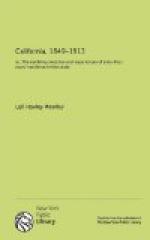The hanging of Stuart seems to have been a very bungling piece of work, but this man’s life was given to evil doing, and the great number of crimes confessed and committed by him would seem to say that he was not deserving of any more sympathy than which he got. This was a sorry spectacle, a human being dying like a dog, but necessity, which dared not trust itself to feelings of compassion, commanded the deed, and unprofitable sentiment sunk abashed.
Two more criminals and I am done with rough characters — Samuel Whittaker and Robert McKenzie, who had been arrested and duly and fairly tried by the Committee. They confessed their guilt and were condemned to be hanged. Their names being familiar and repulsive to all decent citizens. They were hanged side by side in public view on August 24th, 1851. The sight striking terror to the hearts of other evildoers, who were impressed by these examples that they could no longer be safe in San Francisco, such as had been suspected and notified by the Committee, quickly left the city; they, however, found no shelter in the interior.
This brings me to where I took up the Vigilance Committee of 1856.
San Francisco In 1847.
“In view of the great and growing importance of the town of San Francisco (Yerba Buena), situated on the great bay of the same name, we will give our readers a few pertinent and fully reliable statements.
The townsite, as recently surveyed, embraces an extent of one and one-half square miles. It is regularly laid out, being intersected by streets from 60 to 80 feet in width. The squares are divided into lots of from 16 1/2 varas (the Spanish yard of 33 1/3 inches) front and 50 deep, to 100 varas square. The smaller and more valuable of these lots are those situated between high and low water mark. Part of these lots were sold in January last at auction, and brought from $50 to $600. The established prices of 50 and 100 vara lots are $12 and $25.
San Francisco, last August, contained 459 souls, of whom 375 were whites, four-fifths of these being under 40 years of age. Some idea of the composition of the white population may be gathered from the following statement as to the nationality of the larger portion: English, 22; German, 27; Irish, 14; Scotch, 14: born in the United States, 228; Californians, 89.
Previously to the first of April, 1847, there had been erected in the town 79 buildings, nearly all of which had been erected within the two years preceding, whereas in the next four months 78 more had been constructed.




